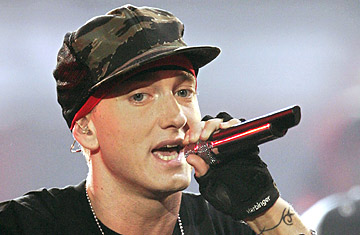
Rapper Eminem.
The Way I Am
Eminem with Sacha Jenkins
Dutton; 208 pages
The Gist:
Since he swaggered into America's living rooms nearly a decade ago, Eminem has been a fixture not only of the hip-hop world but of popular culture: the tortured white rapper of prodigious talent who can't quite come to grips with his fame. His dizzying rise made him the subject and star of the movie 8 Mile and the target of critics, who assailed him for spouting bigoted, misogynistic lyrics. All along, Eminem has griped that neither fans nor foes really understood him. In The Way I Am, a recently released "self-portrait" unmediated by movie avatars or record company censorship, he sets the record straight.
Highlight Reel:
1. His was truly a hardscrabble upbringing. Abandoned by his father, he bounced from school to school, finally cutting his losses after failing the ninth grade three times. Two of his uncles committed suicide. Forced to forge new acquaintances so often, he found himself torn "between being the class clown and being the shy kid" bullies pounded on — and wound up inhabiting both characters. Out of the struggle to continually remake himself sprang three distinct on-stage personas: Marshall Mathers (his real name), who raps earnestly about the joys of fatherhood and the oppression of celebrity; Eminem, "the emcee who goes onstage sober and spits his metaphors"; and alter ego Slim Shady, "the guy who shows up after a few shots of Bacardi — and wants to fight." Repressing this last figure is a battle whose victory only comes with maturity. "We've all got Slim Shadys up inside of us," he writes. "Most responsible adults know how to ignore that dude or chick. I'm a lot better at it these days."
2. Eminem has a "fascination" with the movie Rain Man. He considers the Dustin Hoffman character a kindred spirit: whereas Hoffman boasted a facility with numbers, he is the rapper-savant. "This is all I know how to do," he says. "I can get in my car and drive, but I don't know how to get places." He sells himself a bit short: in addition to being a devoted father, he's a talented graphic artist, and the book contains a series of impressive sketches depicting the superheroes of rap (Tupac Shakur, 50 Cent, himself) and comic books (the Incredible Hulk, Spiderman).
3. The book includes images of the white loose-leaf pages on which he jotted down the similes and metaphors from which his lyrics originate. But his range of talents doesn't include organization. Instead of revealing the inner turmoil of a twisted genius, these scratchings just seem like a jumble of non-sequiturs, like a word-association game played among asylum residents. (A characteristic sequence of "thoughts": Without Me, Mom, Let us Live, Violence, I Am, Kim, Hell Freezes, Kill You.) In part, he says, this haphazardness is by design. "Reading my lyric sheets even gets confusing for me sometimes," he admits. "I'll skip words so people can't ever figure out where I'm going, just in case my written words slip away into the wrong hands." Frustrating as that may be for readers, this safeguard against creative theft illuminates the tooth-and-nail feistiness required to reach the pinnacle of rap.
4. Even after word of his talent began to spread, his road to success was plagued with potholes. He split with one manager over a Burger King Whopper — Eminem couldn't afford one and figured any manager unwilling to shell out for a client's lunch wasn't serious about the rapper's prospects. And while the opening scene in 8 Mile — in which his character suffers stage fright during a rap battle — may have been cinematically embellished, he "choked" in the finals of a 1997 battle in Ohio, returning to Detroit "depressed and totally broke."
The Lowdown:
If you saw 8 Mile, you're familiar with much of Eminem's story already, and unfortunately the narrative is crisper on the silver screen. Though sprinkled with anecdotal gems, this tangled history veers closer to "annotated picture book" than autobiography and crumples under the weight of too many half-baked attempts at introspection. The book's structure, it seems, was dictated not by laziness but by personal philosophy: he's not much of a reader. ("If there are no pictures in a book, forget it.") But he doesn't seem much for writing, either. Die-hard fans will be eager for the backstage access, but all others should take a pass — we've seen this song-and-dance before.
The Verdict: Toss
